Archive for June, 2011
Not just a tasting room: Touring Sonoma’s Wine Valleys
Last week, the UPS truck brought a box of wine from California, reminding me just how late I am in writing something about our tour of Sonoma's Russian River and Dry Creek Valleys. The box contained bottles we had purchased in visits to five separate vineyards, and each told its own story — one of terroir, another of organic viticulture methods, and yet another of vines that were planted in the century before the last one.
It was a wonder that we ended up collecting any of these bottles and their stories. When we first 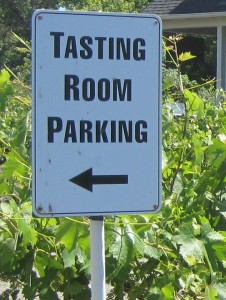 started planning the tour, I had thought we might visit some of the vineyards that make wines I know and like, such as Simi, a Healdsburg-based winery that makes a Cab I enjoy. But we signed up with Valley Wine Tours, and in the weeks leading up to the trip, I exchanged a series of emails with our tour guide, Bob Howells, who helped me think through the options. "We can go there," he said about one of my choices. "But it's just a tasting room."
started planning the tour, I had thought we might visit some of the vineyards that make wines I know and like, such as Simi, a Healdsburg-based winery that makes a Cab I enjoy. But we signed up with Valley Wine Tours, and in the weeks leading up to the trip, I exchanged a series of emails with our tour guide, Bob Howells, who helped me think through the options. "We can go there," he said about one of my choices. "But it's just a tasting room."
That made sense. We were looking for something more than another tasting room experience. As we get closer to planting vines (beyond the 14 experimental vines we are tending on two different properties), our primary focus is on educational opportunies.
Martinelli converted this lovely barn into a tasting room.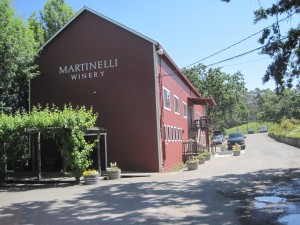
What we were looking for on this trip were wineries where we'd have an opportunity to chat with winemakers, vineyard managers and owners. Until my email exchange with Bob, it hadn't occured to me that we wouldn't get that at the larger wineries that ship back to the east coast.
After providing that bit of counsel, Bob was extremely helpful in planning our itinerary. I was particularly interested in three Sonoma AVAs — the Alexander Valley, Dry Creek Valley and the Russian River Valley — and he provided a list of six vineyards for each. After a couple of hours of research at Total Wines in Chantilly, I discovered that the wines from these vineyards were generally not available in stores on the east coast.
So far, so good, then. We would visit wineries that we would otherwise never experience. We decided to eliminate Alexander Valley, even though it is a great terroir for Cabernet, my favorite grape varietal. We couldn't do all three, and Bob said it would be easier to get the experience we were looking for in the other two AVAs. And he promised we would have an opportunity to discuss wine with knowledgable people who are passionate about what they do.
We visted five wineries that day: Martinelli Winery, Inman Family Wines, Battaglini Estate Winery, Talty Vineyards and Winery, and Truett-Hurst Vineyards. We loved them all, each for different reasons and each because it contributed in a different way to our education. Martinelli, for example — perhaps the largest of the vineyards we visited — was all about terroir. The Martinelli family has more than 300 acres planted, but only 15 percent goes to their own labels, while the rest is sold to other wineries. We tasted Chardonnays from three separate vineyards that are part of their property, and each was distinctly different. The Woolsey Road vineyard, for example, is a packed-clay soil, and the wine had pronounced mineral notes, while the Three Sisters vineyard, more of a sandy loam soil, featured a much softer, more buttery Chard.
While I liked all five vineyards, I'll focus on two here, Inman and Battaglini. Both were extemely generous with their time, and both offered the kind of unique educational experience we were seeking.
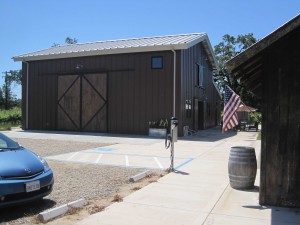
- Inman Family Wines is a small, family-run vineyard and winery focused on the production of elegant Pinot Noirs.
We bumped into Kathleen Inman even before we got into the winery. She was busy arranging outdoor furniture to prepare for the day's visitors, but she took out an hour of her time out to talk to us about the vineyard. Kathleen is big into organic viticulture, and she discussed the organic sprays they use, which are not as easy to find as the non-organic variety and significantly more expensive. Some of the vineyard consultants I've talked to back on the east coast are dismissive of organic sprays, but Kathleen is getting great results.
We spent some time talking about canopy management, including her determination to remove all lateral shoots from the vines. Laterals are extraneous shoots situatued just above a leaf, which are in a sense "a shoot coming out ot a shoot." The leaf is valuable, since it contributes to photosynthesis. The lateral simply drains energy from the vine. In addition, removing laterals provides a bigger bang for the buck when thinning the canopy. Pulling a lateral removes three or more leaves at once, compared to the removal of a single leaf. Kathleen also showed us the equipment she uses to make "compost tea," a liquid brewed from compost that can be used to add nutriets to the soil or to protect the canopy from disease.
One surprise: To the maximum extent possible, Inman uses natural yeasts, the yeasts that are present on the skin of the grapes. Many, perhaps most winemakers, prefer to kill the natural yeast with potassium metabisulphite, and then add a specific commerically-made yeast to start the fermentation. I don't think I would have the courage to rely on natural yeasts, but after tasting the wine, I don't see how anyone can argue with Kathleen's methods.
And yes, we finally did get around to tasting. We were thrilled in particular with the Pinots, which were lush and balanced with nice acidity — perfect for food. Pinot Noir is one of the most difficult grapes to grow, and Kathleen's passion for Pinot Noir is clearly evident in her wines. In addition to some Chardonnay, we purchased the 2007 Thorn Ridge Pinot Noir. While I don't pretend to have the world's most sophisticated sense of smell or taste, I picked up blackberry and dark fruit on the nose, and tasted dark cherry in particular on the palate. A fabulous Pinot.
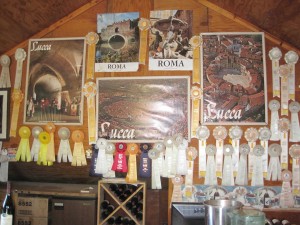
- Joe Battaglini's tasting room looks like a page out of a history book. Nothing fancy, but the wine and Joe's company are what counts here.
At Battaglini, we tasted Zinfidels that gave new meaning to the words, "old vine." Owner Joe Battaglini, who hails originally from Luca, Italy, purchased 30 acres in the Russian River valley in 1998, inheriting vines that are now 126 years old.
This is a one-of-a-kind operation. The tasting room is a small corner of what appears to be an old shed, decked out with pictures of Luca, Rome and other Italian cities, plus the many ribbons he's won in wine competitions over the years. After tasting, and before lunch, which we ate at a shaded table outside the tasting room, Joe took us on a tour of the vineyard. The old vines produce very little in the way of grapes, and a corporate-owned winery would have torn them out years ago in favor of young, higher-productivity vines. Joe dotes on his old vines, even giving them names. One, for example, looks like a huge chair, and so Joe named it "the throne."
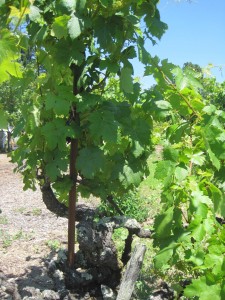 The first thing you notice about the old vines is the lack of trellising. "That's how it was done back then, and how it was when I bought the vineyard," he said. "I didn't want to change anything."
The first thing you notice about the old vines is the lack of trellising. "That's how it was done back then, and how it was when I bought the vineyard," he said. "I didn't want to change anything."
Of course, some things are changing. A modern tasting room is under construction. I suppose it will serve the needs of the winery better, but I can't help but think it will lack the charm of the little shed with the bar and the photos, which remains locked until visitors show up and Joe comes out to greet them. The winery itself is also modern, and after we finished eating the picnic lunch Bob had brought for us, Joe popped out again and offered us a tour.
At the winery, you can choose from 28 Zinfandels, six Petite Sirahs and four Chardonnays. Not a bad selection. We bought a half dozen Zins, and have already enjoyed one. They're ageworthy, but I doubt they'll get that opportunity.
Me, Joe and the Vineyard Goddess, after a tasting.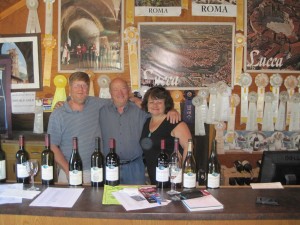
Finally, returning to the sub-theme of this post, the afternoon before this tour, we passed by the Benziger Family Winery after a visit to the Jack London state park (which includes a great museum, with lots of history related to this uniquely American writer) and decided to stop in. We've been there once before, and enjoyed it thoroughly. On our last visit, we took advantage of the tram tour, which shuttles you through the vineyard and on to the crush pad, the fermentation facility and the barrel caves. If you don't take the tram tour, you can still wander through the biodynamic vineyard exhibit, a garden-like setting that explains the vinyeard's green approach to growing grapes.
This time, we arrived shortly before closing, and had time for a tasting only. It was $10 (perhaps a bit steep?), but the wines were good and the setting quite pleasant. Our server was articulate and friendly, and I asked him how long he had been working at Benziger. Thirteen weeks, he said, which explained why he didn't know much more than might have been contained on a script. He wasn't bad, by any means, just not knowledgeable enough to go beyond some basics on each of the wines.
Benziger: It's hard to imagine a more beautiful vineyard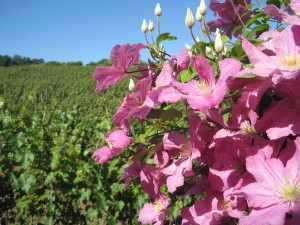
Which made me realize, a day before we began our tour, how right Bob had been in steering me away from a winery I loved that would have been "just a tasting room," in favor of experiences I'll remember for the rest of my life.
Canopy Management, Part II
Here’s some pictures from the weekend class at DuCard Vineyard, thanks to classmate Margaret Frazier, who I have no doubt will one day soon be producing very high quality Virginia wines.
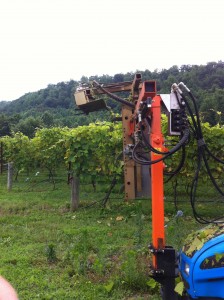
This is the hedger used to trim the tops of the vines in the lyre trellis. It's a bit hard to tell, but the arm of the hedger has whirling blades on both sides, which cuts one arm of the vines.
Canopy Management (And Other People’s Vines)
There's something quite liberating about working on someone else's vines.
Through a class at Piedmont Virginia Community College, we've worked on vines at DuCard Vineyeards now on five separate occasions, starting with dormant winter pruning in late winter and moving on through various stages of the vine's annual growth. On each occassion, I started off, as did many of my classmates, staring at a vine, certain that I was about to ruin it, if not forever, than surely for the season, perhaps costing DuCard a small but meaningful share of its harvest.
Most often, I wanted for DuCard's ever-patient owner, Scot Elliff, or his equally patient vineyard manager, Julien Durantie, to show me just one more time how to do whatever it was that we were expected to do that day. At some point, I would begin working on my own, tentatively at first, but with increasing confidence until at some point, I thought myself almost ready to work without supervision. Continue Reading–>
Grow Tubes Reconsidered
Those of you who have been following this blog know that I recently offered some unkind words about grow tubes, which many vineyards use to nurse along young vines. My criticism was based partly on research and partly on personal experience.
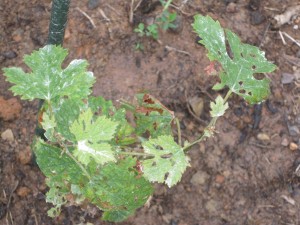
The Nelson vineyard vines, (do seven vines make a vineyard?) after removal of the tubes, leave a lot to be desired.
As I recounted, we had been told in one vineyard management class to use grow tubes, and then, in another, to get them off the vines post-haste. We had two points of reference.
First, our Fairfax vines, which were planted and nurtured without benefit of grow tubes, are doing spectacularly well. It’s possible, of course, that we’re just kidding ourselves, and the growth we’re seeing is the result of overly vigorous vines. While vigor is no
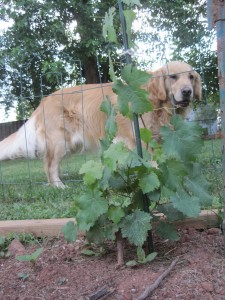
The Fairfax vines (all seven of them) seem to be flourishing, perhaps because Phoenix, the Vineyard Dog, stands guard over them.
doubt welcomed by farmers raising soy or corn, overly aggressive vines produce low-quality fruit. We want the vigor to go to the grapes, not the vines.
Be that as it may, the Fairfax vines appear strong and healthy. By contrast, the vines on our Nelson County property, which were planted with the protective shelter of grow tubes, seem, well, frail. They have holes in the leaves. Lots of holes. And scrawny, brown-looking leaves. Not what we had hoped for at all.
We wondered if the grow tubes were the problem. One of our friends who manages a large vineyard, urged us to take the tubes off, warning that, in this heat, all we were doing was baking the vines. We did some investigating on our own, and much of the research we looked at suggested that the only reason for using grow tubes is to facilitate the use of herbicides – the tubes protect the vine while Roundup or something like that clears vegetation out of the rows of vines.
So, we swore of grow tubes, and I wrote an angry rant about them. I haven’t changed my mind, but in fairness, I have to say that it appears that almost everyone else in this business loves grow tubes. Continue Reading–>
A Tale of Two Vineyards, Part I (In which the origin of the Fairfax vineyard is described.)
The decision to plant vines this year came after a lot of hand-wringing and was made only at the last minute. Looking back, it's hard for me to believe that we agonized so long over this decision. After all, we planted a grand total of 14 vines on two properties, not exactly a huge commitment of time or money. And now that we've worked a bit with them, most of
Digging out the old vegetable garden to make room for vines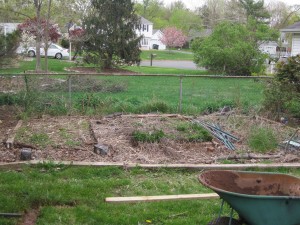
the concerns I had have long since faded away.
At the time, though, I wondered how we would find time to care for them. How we would manage the spray schedules. How we would get the soil ready. And how we would manage the trellising on such short notice.
We ended up planting two vines in Nelson County that were given to us after a class on vine grafting, and once we had those in the ground, we realized this was something we could do. So, I took a leap of faith and ordered a dozen Cab Franc vines from Double A Vineyards, figuring that by the time they arrived, we'd find a way to get the ground ready for planting at both the Fairfax and Nelson County sites. More on the Nelson County vineyard later.
The first pictures show the state of play in the Fairfax vineyard at the time I ordered the vines. It's part of an old garden, plus a bit of lawn that I decided to appropriate in order to provide room for three separate rows.
A closer look at the future Fairfax Vineyard - not a pretty sight, and not much time to prepare.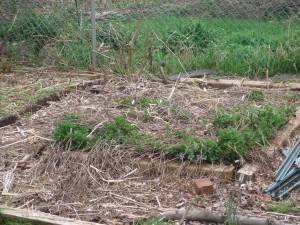
We're not talking big rows: two, with two vines each, and a third with three vines. But it's enough to provide grapes for five gallons of wine, just the right amount to ferment at home.
My first problem was finding the time to prepare the vineyard. We were going out of town most weekends (hanging out at the site of the Nelson County family vineyard), and it was getting dark early. Working when I could, I found time to clear out the growth in the garden, clear the sod in the lawn, and lay out the rows, using eight-foot metal fence posts as a guide. The rows were laid out seven feet apart, and the vines were to be spaced six feet apart.
The vines arrived on April 20, and I realized we would not have time to plant in Fairfax that week. Inside the packaging, the roots were wrapped with shredded newsprint that was still soaking wet. It was probably enough moisture, but I added a bit more water anyhow, and resealed the package. Anything worth doing is worth overdoing, in my humble opinion.
Overdone or not, the vines stayed healthy, and I planted the following week on April 26. Vines may be a bit too big of a word to describe what we actually planted. The plants consisted of a healthy-looking root (101-14 for those of you who care about such things – and if you are interested in establishing your own vineyard, you must care about such things), that ended with the graft union. What I was more familiar with was a plant that had both root and a scion, which is the particular type of vine. Cab Franc, for example, comes in a number of different clones and, again, for those of you who care about such things, these were FPS 04/332, grafted onto the 101-14 rootstock. Except that I couldn't see any part of the scion. In other words — and to get back on point — I was accustomed to seeing vines that looked like vines, not roots with a tiny stub of a graft union on top.
I called the nursery, and was told that the graft union had tremendous growth potential that would be unleashed if I simply hilled it over (covered it with dirt) and waited for the shoots to break through. I felt a bit like Jack and the Beanstalk being told to bury magic beans, but I did it anyhow, and three weeks later I had a bit of growth beneath the hilled-over soil. (It went a bit faster in Nelson County.)
In the foreground, a Cab Franc vine stands 25 inches tall. The one in the background a bit smaller.
We carefully cleared the hilled-over dirt away, making sure that the graft union was at least two inches above ground. The concern is that if the soil manages to come into contact with the scion above the graft union, the vine itself will begin to develop roots and will essentially be growing on its own root. This is a story for another time, but to make it quick, the vine has everything it needs to grow, including the ability to develop roots, but lacks one thing — resistance to Phylloxera, an insect that that nearly destroyed Europe's vineyards in the 19th century. That's why Vinifera vines (Merlot, Cab, Chard, pretty much every varietal you're accustomed to drinking) must be grafted onto American root stock, which is mostly immune to Phylloxera.
We let these vines grow without the grow tubes we used in the Nelson Vineyard. We worried about that decision for a long time (well, weeks) until we decided that grow tubes were creating more problems than they were solving.
In any event, these vines are doing pretty well.
They seem healthy and vigorous (hopefully not too vigorous), and the tallest of the group is about 25 inches. They need to be pruned back, but that's a story for next time. I've included three pictures, including one with Phoenix the Vineyard Dog standing guard from outside the fence.
One footnote: the fence serves to keep Phoenix out, but won't help with rabbits, deer or any of the other Bambi/Thumper-type predators that feed on vines. Very soon, we'll be putting up a deer fence, but for now we're counting on luck to keep these young vines safe.
Phoenix the Vineyard Dog standing guard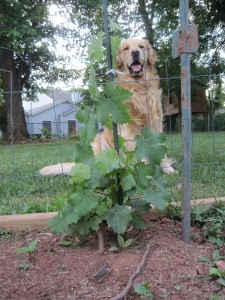
Goodbye to Grow Tubes Forever!
Apparently there’s no agreed-upon rule book for viticulture.
When we planted Cab Franc vines on our Nelson County property, we followed the advice offered at a class on that very subject at the Piedmont Virginia Community College (great curriculum –the best available in Virginia today), and covered them with grow tubes. We
did the same for the two Mammolo Tuscano vines which we had received as a gift from Gabriele Rausse, one of the founding fathers of the Virginia wine industry and the instructor for a class on grafting.
At another class over the weekend, we were told, in no uncertain terms, to take them off. Sigh.
After doing a lot of overnight research, we decided that the grow tubes – ours are the so-called “Blue X,” which consist of a blue plastic insert and a soft-skin translucent blue sleeve – had to go. But it was kind of a close call.
A lot of the research we looked at suggested that while grow tubes provide a hot-house environment that jump starts the growth of the vines in their early months, they also prevent the vines from achieving their potential. The focus of the first two years is developing a strong trunk and root system. As Julien, the vineyard manager at DuCard Vineyards, told me, you must be willing to do the work, and to do it when it needs to be done. And you must be willing to be patient. The tubes, he added, rushed the process and created a hot-house that could cook the vines to death in the 90-plus degree weather we’ve been having.
My wife, the Vineyard Goddess (and future Vineyard Manager), took Julien’s words to heart and found a good deal of evidence to support the anti-grow tube proposition. Continue Reading–>

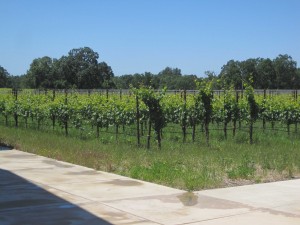
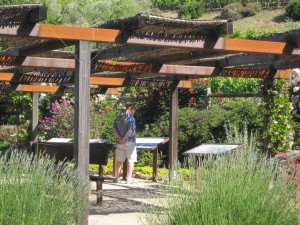
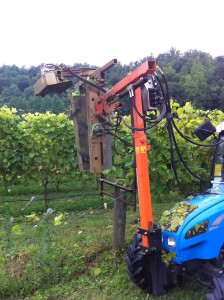
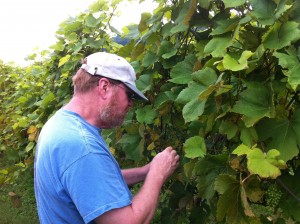
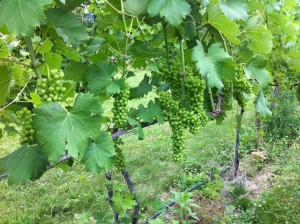
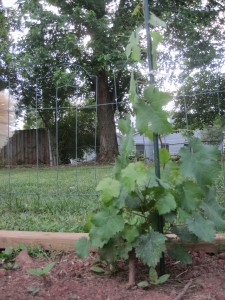
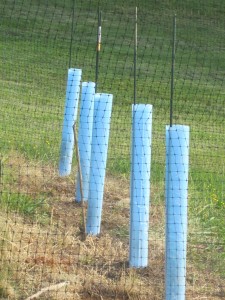


Recent Comments